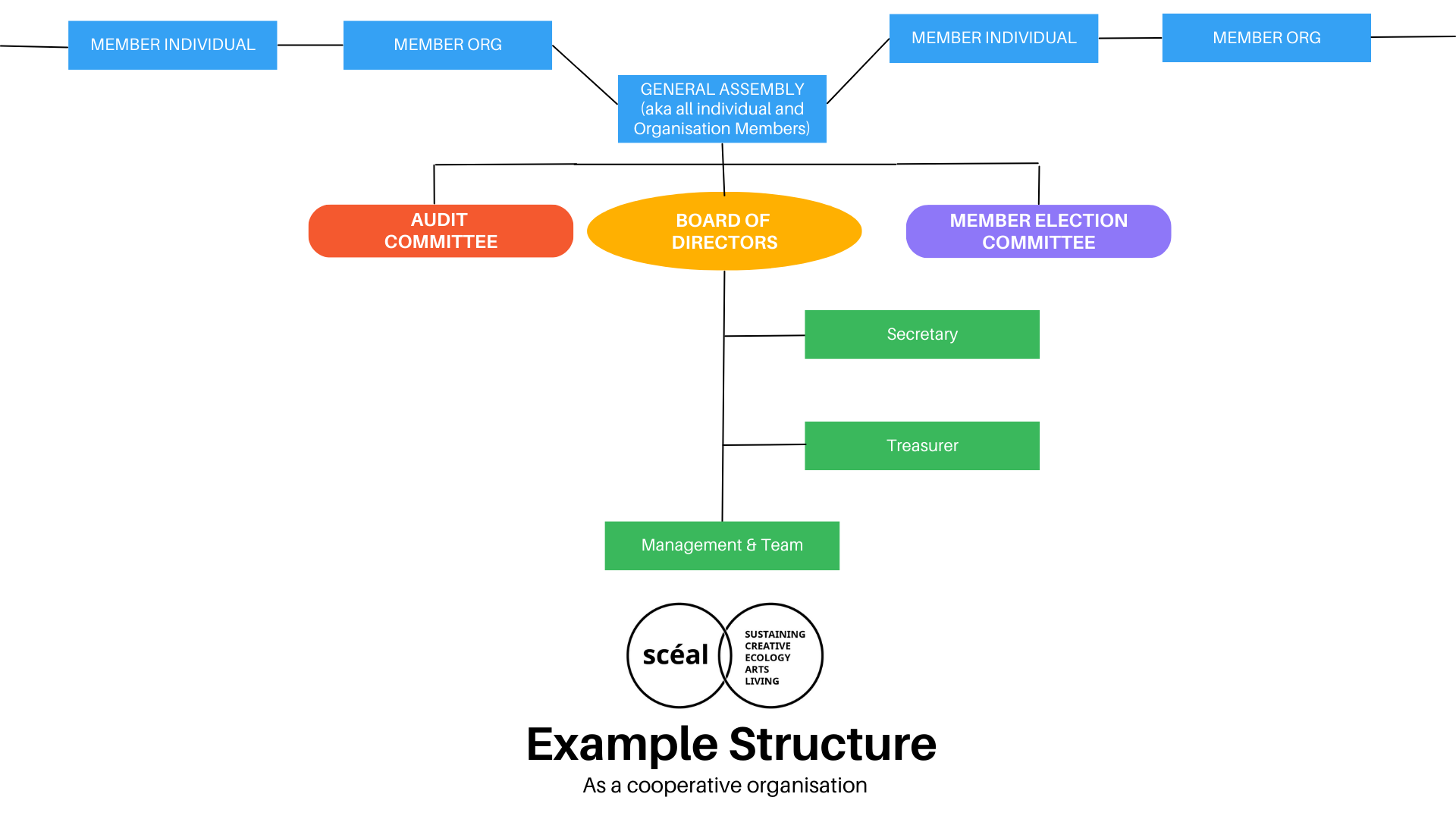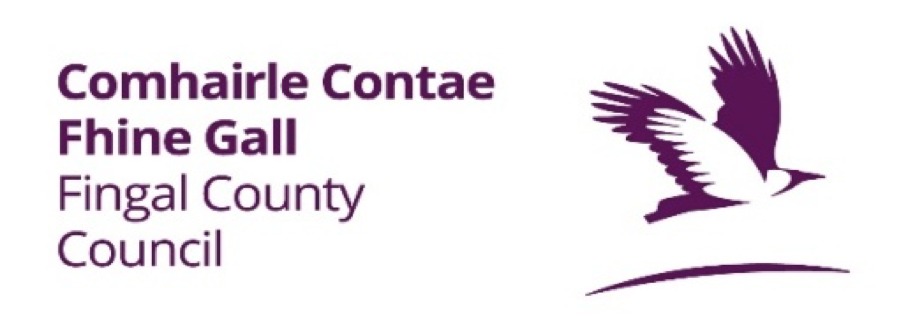SCÉAL CO-OP MODEL
SCÉAL: SUSTAINING CREATIVE ECOLOGY ARTS & LIVING
SCÉAL is a collective of creative people that operates with the principles of a cooperative organisation, with the goal of becoming a legal cooperative organisation in the future.
So, what is a cooperative?
A co-operative is an enterprise which is owned and controlled by its user members and operates for the benefit of its user members.
Cooperatives address market failure and fill gaps that other private businesses ignore and co-ops have lower failure rates than traditional models.
About 10% of cooperatives fail after the first year while 60-80% of traditional businesses fail after the first year. After 5 years, 90% of cooperatives are still in business, while only 3 – 5% of traditional businesses are still operating after 5 years.
This is often because of the many people involved in starting a cooperative and the high level of community support for cooperatives.
The cooperative model proposed enables individuals to be members, but also community groups and organisations to be members.
While SCÉAL may serve clients or the general public to help generate funding, the future co-op may choose to remain artist focused to serve the members needs.
Here is some more information on how a cooperative would work, starting with the industry standard 7 principles of any co-op organisation, quoted directly from The Irish Co-operative Organisation Society (ICOS):
7 PRINCIPLES OF A COOPERATIVE ORGANISATION
Co-operative principles are guidelines by which co-operatives put their values into practice.
- Voluntary and open membership
Co-operatives are voluntary organisations, open to all persons able to use their services and willing to accept the responsibilities of membership, without gender, social, racial, disability, political or religious discrimination.
- Democratic member control
Co-operatives are democratic organisations controlled by their members, who actively participate in setting their policies and making decisions. Men and women serving as elected representatives are accountable to the membership. In primary co-operatives, members have equal voting rights (one member ,one vote), and co-operatives at other levels are also organised in a democratic manner.
- Member economic participation
Members contribute equitably to democratically control the capital of their co-operative. At least part of that capital is usually the common property of the co-operative. Members usually receive limited compensation, if any, on capital subscribed as a condition of membership. Members allocate surpluses for any of the following purposes:
a) Developing their co-operative, possibly by setting up reserves, part of which at least would be indivisible.
b) Benefi ting members in proportion to their transactions with the co-operative.
c) Supporting other activities approved by the membership.
- Autonomy and independence
Co-operatives are autonomous, self-help organisations controlled by their members. If they enter into agreements with other organisations, including governments, or raise capital from external sources, they do so on terms that ensure democratic control by their members and maintain the co-operative identity.
- Education, training and information
Co-operatives provide education and training for their members, elected representatives, managers and employees so that they can contribute effectively to the development of their co-operatives. They inform the general public- particularly young people and opinion leaders- about the nature and benefits of cooperation.
- Cooperation among co-operatives
Co-operatives serve their members most effectively and strengthen the co-operative movement by working together through local, national, regional and international structures.
- Concern for community
Co-operatives work for the sustainable development of their communities through policies approved by their members
POTENTIAL CO-OP STRUCTURE FOR SCÉAL
Below, you will see a high level chart of how the structure might look for SCÉAL as a co-operative:

MEMBERS
You’ll notice straight away in a co-op that members are at the top of the chain. We (members) are the lifeblood of the organisation in a co-op. The board ultimately serves the members, whom each have an equal vote when it comes to decisions that are deemed to need the input of all full membership vote (such as electing board members for instance). How we determine membership levels will be one of the decisions to make after formation.
In a co-op, here are some ways that members can exercise control:
• Voting at annual and membership meetings.
• Electing Board of Directors.
• Making decisions on major cooperative issues.
Other things members may consider or engage with:
• Voting on major decisions • Considering a run for the board • Nominating and electing directors • Amending bylaws, accepting audit report, voting on resolutions/motions • Serving on advisory committees or undertaking special assignments • Learning as much as they can about the cooperative
BOARD OF DIRECTORS
There are 7 board members required for a cooperative to register legally in Ireland, here is a potential model that provides flexibility and support especially at the outset, similar to other legal structures:
- Chairperson
- Vice Chairperson
- Treasurer
- Vice Treasurer
- Secretary
- Director
- Director
Here are some general attributes of effective board members:
- Communicate well • Clearly express their views • Good listener • Are active in community • Have leadership ability • Think independently • Place cooperative’s interests first • Make good business decisions • Make the most of resources available to them • Promote the cooperative • Gets along with others • Uses the cooperative fully • Is interested in its performance • Participates in decision-making • Understands that he/she is representing members whom are owners in their business • Understands his/her role in relation to that of management
Formal Role of the board of directors:
- Manage financial matters of the co-operative: It’s important for the board to have a strong understanding of the co-op’s financial position. This can be done with support from staff or an accountant (depending on the size of the co-op). The board should lead the creation of an annual budget, monitor revenue and expenses, and present the annual return and budget back to the members at the annual meeting. Some members of the board will have signing authority on the co-op’s accounts and their signatures will be required for items like cheques, agreements, accounts, annual returns, and applications.
- Strategic Planning: The board provides leadership to the organization and shapes its direction. It creates, updates, and maintains strategic plans that include the co-op’s agenda, goals, and key opportunities. The board should regularly identify projects and manage the co-op’s investments.
- Create policies and procedures: The board will create policies when first incorporating the co-op, and on an ongoing basis. Some policies will be created in response to the co-op’s business, or as challenges and opportunities arise. These policies relate to things like finances, membership, conflict of interest, information and technology, safety, and elections.
- Give the co-operative a voice publicly: Both the board and the management will promote the co-op to the public. The board, as representatives of the members, should speak on behalf of the co-op when working with partners, funders, media, or other audiences. They should provide information to members at meetings and give direction to staff. It’s good to have a communications strategy for the board and management that outlines how the co-op communicates with other parties, so everyone is sharing a consistent message.
- Management: The board help oversee the management team (and in early days will handle management tasks until more resources are found) and will have the final say on many important decisions and may have to deal with conflict or debate that could arise. For example, it’s the board’s job to decide how to allocate the co-op’s profits. To do this, it needs to take a number of things into consideration: adding to reserve funds, investing in the co-op, and distributing profit to members. Decisions like this can lead to conflict, but the co-op can help avoid this by including members in the discussion (and listening to their ideas).
- Engage the members: At the end of the day, the co-op exists to serve its members. The board should engage members in important decisions and happenings with the co-op. The board can help ensure members have a sense of ownership with their co-op by communicating openly with them.
The Irish Co-operative Organisation Society (ICOS)
is a unifying force for the Irish co-operative movement.
REGISTERING A CO-OP
ICOS is the main body for cooperatives in Ireland, stating “Our core business is to provide vision, leadership and value to the co-operative movement in Ireland. We use our collective voice to put the needs of the co-operative movement and our member co-ops to the forefront of what we do.”
You can learn more about starting a co-op in Ireland on the ICOS website: https://icos.ie/starting-a-co-op/intro/
Further reading for those really interested in cooperative governance:
Government approves the drafting of ground-breaking legislation for the Co-operative sector:
https://enterprise.gov.ie/en/news-and-events/department-news/2022/november/202211161.html
ICOS response to proposed legislation:
Deep detail for those that are VERY interested in the boring stuff:
Proposed Legislation: General Scheme of the Co-operative Societies Bill 2022 accompanied by RIA
https://enterprise.gov.ie/en/legislation/general-scheme-co-operative-societies-bill-2022.html
Cooperative Overview: This is from the US and for large cooperative models but gives context
https://www.rd.usda.gov/sites/default/files/publications/CIR11_Co-opEssentialsPowerpoint.pdf



